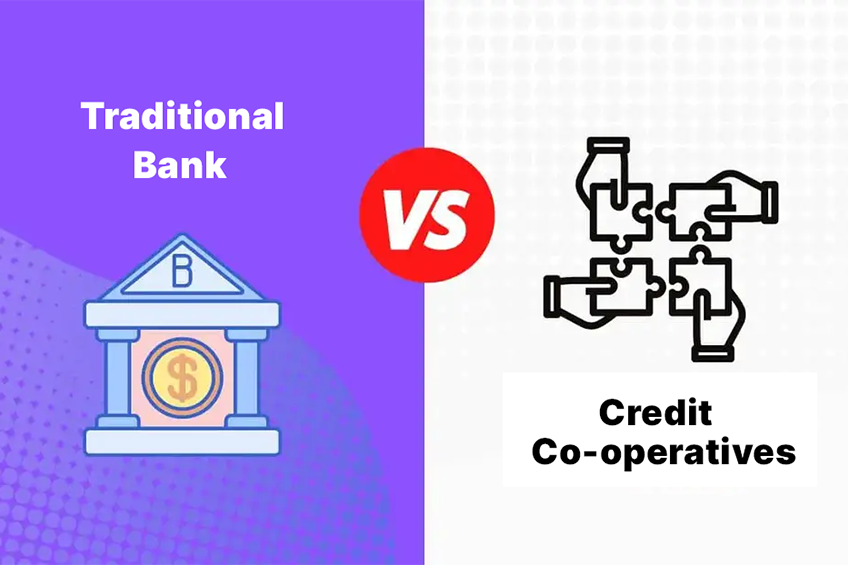Introduction
When it comes to managing our finances and seeking financial services, we often encounter two main options: credit co-operatives and traditional banks. While both provide banking services, they differ in various aspects that can significantly impact your financial journey.
In this beginner's guide, we will delve into the key differences between credit co-operatives and traditional banks, empowering you with the knowledge to make informed decisions about your financial needs.
Structure and Ownership
Credit Co-operatives
Credit co-operatives are unique in their structure, functioning as member-owned and member-controlled entities. The members, often residing within a specific community or belonging to a particular group, come together to establish the co-operative.
By pooling their resources, they create a financial institution that serves their collective interests. Each member has a say in the decision-making process, with voting rights based on the principle of "one member, one vote."
Traditional Banks
On the other hand, traditional banks operate as corporate entities with shareholders. They are primarily profit-driven and answerable to their shareholders. The ownership of traditional banks is distributed among individual or institutional shareholders who invest in the bank's stocks.
Decision-making authority lies with the board of directors and executive management, who work towards maximising shareholder value.
Focus and Purpose
Credit Co-operatives
Credit co-operatives prioritise their members' needs and welfare. They exist to promote financial inclusion, provide access to affordable financial services, and support community development.
The primary focus of credit cooperatives is to serve their members and foster a sense of financial empowerment among the community they cater to.
Traditional Banks
Traditional banks have a broader target audience, serving individuals, businesses, and various sectors of the economy. Their primary objective is to generate profits and achieve financial stability.
While traditional banks offer a wide range of financial products and services, their approach is more profit-oriented, aligning with the interests of their shareholders.
Access to Financial Services
Credit Co-operatives
Credit co-operatives often cater to specific communities or groups, such as employees of a particular organisation or residents of a locality. This targeted approach allows them to understand their members' unique financial needs and offer personalised services.
By establishing close relationships with members, credit co-operatives aim to provide a more holistic and tailored banking experience.
Traditional Banks
Traditional banks serve the general public and offer financial services to a diverse customer base. They have a wider network of branches and ATMs, making their services easily accessible.
Traditional banks provide a comprehensive range of products and services, including savings accounts, loans, credit cards, investment options, and more, catering to the varied needs of their customers.
Decision-making and Governance
Credit Co-operatives
In credit co-operatives, decision-making processes are democratic and member-driven. Each member has an equal say in major decisions, irrespective of the number of shares held or the amount of money invested. This democratic structure allows members to actively participate in shaping the policies and direction of the co-operative.
Traditional Banks
Traditional banks follow a hierarchical decision-making structure. The board of directors, appointed by the shareholders, is responsible for setting the bank's strategic direction.
Executive management implements these decisions, ensuring efficient operations and adherence to regulatory requirements. While customer feedback is considered, the decision-making process is not as participatory as in credit co-operatives.
Risk and Return
Credit Co-operatives
Credit co-operatives prioritise the welfare of their members and the community over maximising profits. Consequently, they may offer lower interest rates on loans and deposits compared to traditional banks. While this may result in relatively lower returns, it also helps in minimising the financial burden on members and providing affordable financial solutions.
Traditional Banks
Traditional banks aim to strike a balance between risk and profitability. They evaluate the risk associated with lending and adjust their interest rates accordingly. Banks also provide a wide range of investment options with varying risk profiles, enabling customers to choose based on their risk tolerance and return expectations.
Regulation and Oversight
Credit Co-operatives
Credit co-operatives are regulated by cooperative laws and cooperative departments specific to each jurisdiction. These regulations ensure compliance with cooperative principles, governance practices, and financial disclosures. The regulatory framework promotes transparency, accountability, and responsible management of co-operatives.
Traditional Banks
Traditional banks operate under the regulatory framework of banking laws and financial regulatory bodies. These regulations are designed to maintain the stability of the banking system, protect customer interests, and ensure adherence to prudential norms. Regulatory oversight ensures banks meet capital adequacy requirements, maintain proper risk management practices, and safeguard customer deposits.
Conclusion
Understanding the differences between credit co-operatives and traditional banks is crucial for making informed decisions about your financial needs.
Credit co-operatives emphasise member ownership, community development, and personalised services, while traditional banks prioritise profit generation and serve a wider customer base.
By considering the distinctive features of each option, you can choose the financial institution that aligns best with your goals, values, and requirements.
Remember, whether you opt for a credit co-operative or a traditional bank, conducting thorough research and assessing your financial goals will guide you in making the right choice that meets your unique needs.


